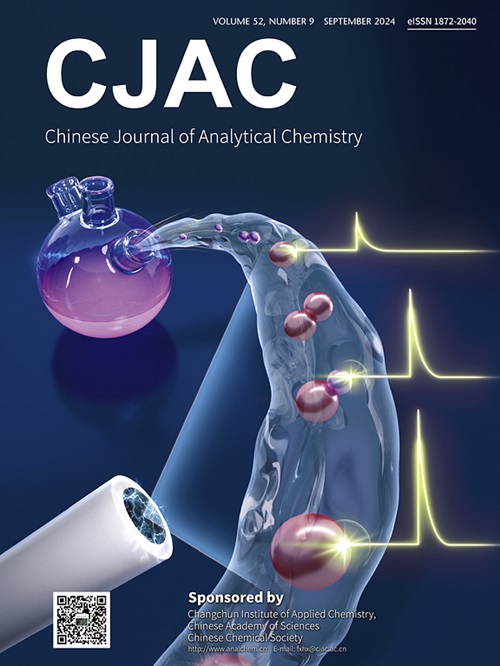改良QuEChERS - UPLC-MS/MS法测定沉积物中违禁药物
IF 1.3
4区 化学
Q4 CHEMISTRY, ANALYTICAL
引用次数: 0
摘要
世界各地广泛报道了水中存在非法药物的情况,但沉积物的数据有限,这可能是由于缺乏有效和可靠的分析方法。本研究建立了测定沉积物中安非他命、甲基苯丙胺、甲卡西酮、麻黄碱、3,4-亚甲基二氧基苯丙胺、3,4-亚甲基二氧基-n-甲基苯丙胺、去氯胺酮、氯胺酮、苯甲酰ecgonine、可待因、可卡因、美沙酮等12种违禁药物的灵敏方法。优化了QuEChERS方法中盐溶液(萃取步骤)和吸附剂(纯化步骤)的组合,提高了分析方法的适用性和可靠性,并将其与超高效液相色谱-串联质谱(UPLC-MS/MS)相结合。所开发的方法具有良好的线性(R2 >;0.995)在0.1 ~ 50 ng/g干重(dw)范围内,检测限和定量限分别为0.0077 ~ 0.0299 ng/g dw和0.0255 ~ 0.0996 ng/g dw。加样回收率为60.5% ~ 114.9%,日内、日内相对标准偏差分别小于10.9%和12.3%,均在可接受范围内。将该方法应用于中国北云河流域的沉积物中,发现12种靶向药物中有9种存在。药物总浓度范围为0.12 ~ 1.18 ng/g dw,以麻黄碱为主,其次为安非他明和美沙酮。生态风险评价表明,检测到的药物对水生生态系统的生物危害较低。然而,由于非法药物的高极性和生物活性,继续注意其生态风险将提供更大的保证。本研究首次应用QuEChERS从沉积物中提取违禁药物。优化后的方法阐明了这些新出现的污染物的行为,有助于准确的环境风险评估。该方法灵敏度高,回收率好,精密度高,适用于复杂沉积物基质中痕量违禁药物的常规监测。本文章由计算机程序翻译,如有差异,请以英文原文为准。

Determination of illicit drugs in sediments using a modified QuEChERS method coupled with UPLC-MS/MS
The occurrence of illicit drugs in water has been extensively reported around the world, however, limited data are available in sediments, probably due to the lack of effective and robust analytical methods. This research established a sensitive method for determining 12 illicit drugs, including amphetamine, methamphetamine, methcathinone, ephedrine, 3,4-methylenedioxy-amphetamine, 3,4-methylenedioxy-n-methamphetamine, norketamine, ketamine, benzoylecgonine, codeine, cocaine, and methadone in sediments. The combination of salt and solution (extraction step) and adsorbents (purification step) in the QuEChERS method was optimized to enhance the applicability and reliability of the analytical approach, which was subsequently combined with ultra-performance liquid chromatography-tandem mass spectrometry (UPLC-MS/MS). The developed method demonstrated satisfactory linearity (R2 > 0.995) within 0.1 to 50 ng/g dry weight (dw), with limits of detection and quantification ranging from 0.0077 to 0.0299 ng/g dw and 0.0255 to 0.0996 ng/g dw, respectively. Recoveries of target drugs ranged from 60.5 % to 114.9 %, with intra-day and inter-day relative standard deviations below 10.9 % and 12.3 %, respectively, which are within the acceptable limits. Application of the validated method to sediments from the Beiyunhe River Basin, China revealed the presence of nine out of twelve targeted drugs. Total drug concentrations ranged from 0.12 to 1.18 ng/g dw, with ephedrine being predominant, followed by amphetamine and methadone. Ecological risk assessments indicated low biological hazards from the detected drugs to aquatic ecosystems. However, due to their high polarity and biological activity, continued attention to the ecological risks of illicit drugs would provide greater reassurance. This research presents the first application of QuEChERS for extracting illicit drugs from sediments. The optimized method elucidates these emerging contaminants' behavior and facilitates accurate environmental risk assessments. Due to its high sensitivity, good recovery and precision, the method is well-suited to routine monitoring of trace-level illicit drugs in complex sediment matrices.
求助全文
通过发布文献求助,成功后即可免费获取论文全文。
去求助
来源期刊
CiteScore
3.60
自引率
25.00%
发文量
17223
审稿时长
35 days
期刊介绍:
Chinese Journal of Analytical Chemistry(CJAC) is an academic journal of analytical chemistry established in 1972 and sponsored by the Chinese Chemical Society and Changchun Institute of Applied Chemistry, Chinese Academy of Sciences. Its objectives are to report the original scientific research achievements and review the recent development of analytical chemistry in all areas. The journal sets up 5 columns including Research Papers, Research Notes, Experimental Technique and Instrument, Review and Progress and Summary Accounts. The journal published monthly in Chinese language. A detailed abstract, keywords and the titles of figures and tables are provided in English, except column of Summary Accounts. Prof. Wang Erkang, an outstanding analytical chemist, academician of Chinese Academy of Sciences & Third World Academy of Sciences, holds the post of the Editor-in-chief.

 求助内容:
求助内容: 应助结果提醒方式:
应助结果提醒方式:


